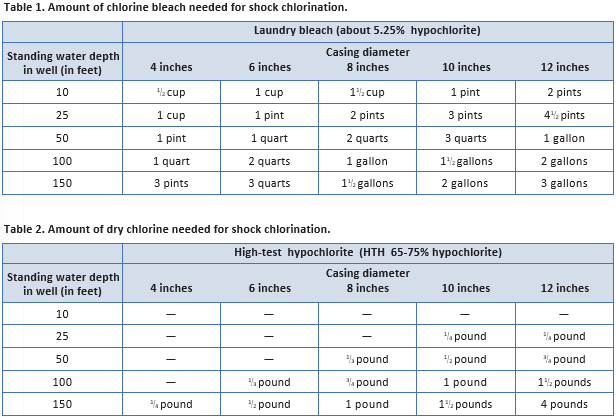Mark L. McFarland, Associate Professor and Extension Soil Fertility Specialist
Monty C. Dozier, Assistant Professor and Extension Specialist — Water Resources, The Texas A&M University System
Craig Runyan, Program Coordinator, Extension Plant Sciences Department, New Mexico State University
If your well has been flooded, it will need to be shock chlorinated before you can use it as a drinking water source. You will need to add chlorine to the well water to kill any disease-causing organisms that may have entered it during the flood.
In addition to the well, you should also disinfect most water treatment equipment, such as water heaters, softeners and pressure tanks. During the shock chlorination process, temporarily disconnect or bypass drinking water filters such as carbon filters and reverse osmosis systems.
During the disinfection process, water from the system is unsuitable for consumption; do not allow people or animals to have prolonged contact with it. Make the treatment when faucets and toilets will not be in use for at least 12 hours, preferably 24 hours. If there is an automatic watering system for animals and irrigation, provide an alternative water source during the treatment period.
The two most common sources of chlorine for well disinfection are dry chlorine (65 percent calcium hypochlorite) and liquid household bleach (5.25 percent sodium hypochlorite). Do not use bleach with a “fresh scent,” lemon fragrance or other additives.

Chlorination procedure
The amount of chlorine needed is determined by the amount of water standing in the well. The standing water depth in the well is the depth of the well minus the static water level, which is the level of the water table in a well when the pump is not operating.
If you do not know the well’s standing water depth, use a volume of bleach equal to twice the depth value for the diameter of the well casing (see Table 1 or 2). For example, an 8-inch casing diameter with unknown standing water depth would require 3 gallons of household bleach.
Drain as much water from the system as possible. If the system has a pressure tank that contains a bladder, the chlorine solution may damage the rubber air-water separator in the tank. Check your manufacturer’s guide to see if the pressure tank should be bypassed. If the pressure tank has no bladder, release the air to allow the tank to be filled with chlorinated water. Drain all hot water heaters to allow chlorinated water to circulate through the hot water system also.
Remove the plug or screen on the well cap to access the inside well casing. Dilute the beach by placing the appropriate amount of bleach (see Table 1 or 2) in a 5-gallon bucket and filling the bucket with clean water. Use a funnel to pour the solution around the sides of the well casing.
Connect a garden hose to a nearby faucet and wash down the inside of the well. Continue the washing process for 10 minutes, and make sure you can smell a strong chlorine odor. Then, do not operate the water system for 2 hours.
After 2 hours, open the faucet closest to your well. Allow the water to run until you can smell a strong odor of chlorine, then close the faucet. Go to the next faucet and repeat. If you do not smell the odor, check the chlorine rate and add more chlorine to the well, repeating steps 1 through 4. Then, do not operate the water system for at least 12 hours, preferably 24 hours.
Next, flush the remaining chlorine from the system. Begin by turning on the outside faucets and letting the water run until the chlorine odor dissipates. Let the water run on the ground to reduce the load on your septic system. However, do not let the chlorinated water run onto lawns, gardens or other plants because chlorine can injure them. Place the garden hose so that it drains into a field or low-lying area away from desirable plants. Be careful not to discharge the chlorinated water directly into a pond, lake, river or stream.
Turn on the indoor faucets until the system is completely flushed.
After chlorination, have the well water tested again for bacterial contamination. If bacteria are still detected in the well water, repeat the chlorination process and then test the water again.
If bacterial contamination is detected a third time, check for potential sources of reinfection such as an improperly designed wellhead or livestock pens or septic tanks near the wellhead. You may need to install a continuous chlorination system or other continuous disinfection system.
—
Download, save or print this resource before a disaster happens!
Disinfecting Water Wells by Shock Chlorination ( En Español )
Information in this publication came from University of Nebraska publication G95-1255A, Auburn University publication ANR-790, Texas Natural Resource Conservation Commission publication GI-005, and other sources.
For more information, see http://soilcrop.tamu.edu or http://water.tamu.edu.
“Flood” (CC BY-ND 2.0) by Sean Davis
